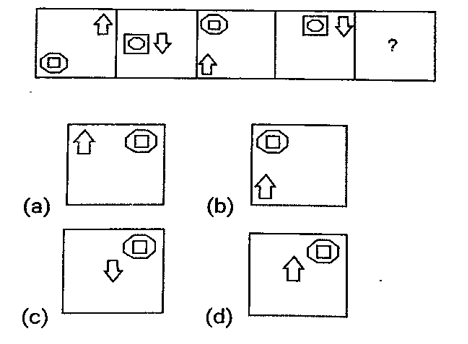Question 1:
Which option will come in place of question mark (?) in the given series.
5 23 95 ? 1535 6143 24575
दी गई श्रृंख्ला में कौन सा विकल्प प्रश्नावाचक चिन्ह (?) के स्थान पर आएगा।
5 23 95 ? 1535 6143 24575
Question 2:
Find the missing number.
लुप्त संख्या ज्ञात कीजिए ।

Question 3:
Choose the set in which the numbers are related in the same way as the numbers in the following sets.
उस समुह को चुनिए जिसमें संख्याएं ठीक उसी प्रकार संबंधित हैं जिस प्रकार निम्नलिखित समुच्चयों की संख्याएं संबंधित हैं ।
(Note: Operations must be performed on whole numbers, without breaking the numbers into their constituent digits. Ex. 13 – Operations such as addition/subtraction/multiplying 13 etc. can be performed on number 13. Breaking 13 into 1 and 3, and then performing mathematical operations on 1 and 3 is not allowed)
(ध्यान दें: संख्याओं को उनके घटक अंकों में अलग-अलग किए बिना, संक्रियाएं पूर्ण संख्याओं पर की जानी चाहिए। उदा. 13 - संख्या 13 पर संक्रियाएं जैसे 13 को जोड़ना/घटाना/गुणा करना आदि किया जा सकता है। 13 को 1 और 3 में अलग-अलग करने की, और फिर 1 और 3 पर गणितीय संक्रियाएं करने की अनुमति नहीं है)
(3, 5, 18)
(2, 3, 15)
Question 4:
In a certain code language, “QUIRKY" is written as 'TCLZNG' and 'MUZHIK' is written as 'PCCPLS'. How will 'FROWZY' be written in that code language?
एक निश्चित कूट भाषा में, “QUIRKY" को 'TCLZNG' के रूप में लिखा गया है और 'MUZHIK' को 'PCCPLS' के रूप में लिखा गया है। उस कूट भाषा में 'FROWZY' को कैसे लिखा जाएगा ?
Question 5:
Three statements are given followed by four conclusions numbered 1, 2, 3 and 4. Assuming the statements to be true, even if they seem to be at variance with commonly known facts, decide which of the conclusions logically does not follow from the statements.
तीन कथन और उनके बाद चार निष्कर्ष क्रमांक 1, 2, 3 और 4 दिए गए हैं। कथनों को सत्य मानते हुए, भले ही वे सामान्य रूप से ज्ञात तथ्यों से भिन्न प्रतीत होते हों, निर्णय करें कि कौन सा निष्कर्ष तार्किक रूप से कथनों का अनुसरण नहीं करता है।
कथन: Statements
सभी P, G हैं । All P are G.
कुछ G, B हैं। Some G are B.
सभी B, C हैं । All B are C.
निष्कर्ष : Conclusions:
1) सभी P के C होने की संभावना है। All P are C is a possibility.
2) कुछ P, B हैं। Some P are B.
3) कुछ C, G हैं । Some C are G.
4) कुछ G, P हैं। Some G are P.
Question 6: 
Question 7:
Six brothers K, L, M, N, O and S are standing in a row facing north. K is standing exactly behind N. O is standing exactly between M and S. Only three brothers are standing behind L. Who is standing exactly behind K?
छ: भाई K, L, M, N, O और S एक कतार में उत्तर की ओर मुख करके खड़े हैं। K, N के ठीक पीछे खड़ा है। O, M और S के ठीक बीच में खड़ा है । केवल तीन भाई L के पीछे खड़े हैं। K के ठीक पीछे कौन खड़ा है ?
Question 8:
On interchanging the given two signs + and – and two numbers 17 and 216 (not digits), which of the following equations will be correct?
दिए गए दो चिह्नों + और – तथा दो संख्याओं 17 और 216 (अंकों को नहीं) को आपस में बदलने पर, निम्नलिखित में से कौन-सा समीकरण सही होगा?
1. 10 × 216 + 17 ÷ 6 – 13 = 146
II. 7 × 216 + 41 – 17 – 36 = 81
Question 9:
Choose the option that best represents the arrangement of the following words in a logical and meaningful order.
उस विकल्प का चयन करें जो निम्नलिखित शब्दों की व्यवस्था को तार्किक और सार्थक क्रम में दर्शाता है।
1. जाँच Inquiry
2. आवेदन Application
3. साक्षात्कार Interview
4. नौकरी प्रस्ताव Job offer
5. नौकरी शुरू Job start
Question 10:
Directions :- Choose the figure which will replace the question mark (?) or will come next in the following figure series.
दिशा निर्देश :- उस आकृति का चयन करें जो प्रश्नवाचक चिह्न (?) की जगह लेगी या निम्नलिखित आकृति श्रृंखला में आगे आएगी।







